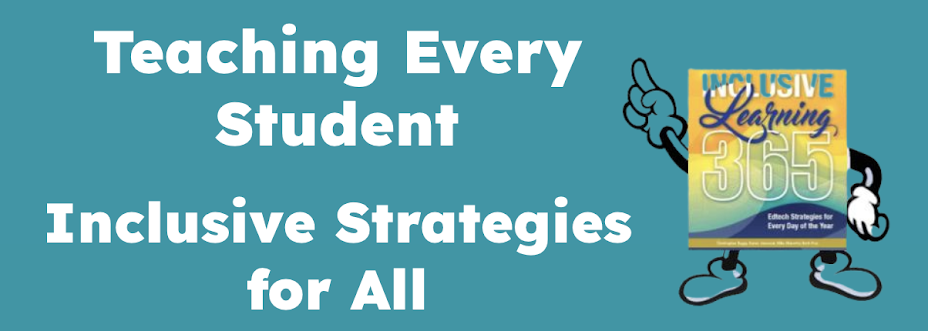It's been almost three months since my last post. I've written hundreds in my head but none of them made it to the website. So, I'm starting with rethinking editing.
In my experience, editing is one of the least preferred activities for students. Many students believe since they've written it and used pre-writing strategies such as outlines or graphic organizers, then it must be good enough. Or, they've put so much energy into the first draft, they have nothing left for the revision process. Too often, they fail to see the value of editing to improve the quality of their written work.
How are you teaching the editing process? Have you incorporated technology as part of your instruction?
Technology allows new editing methods and strategies. Here's one I've been working on for some time.
Technology Editing Method:
a) Disable spell and grammar check when the student is writing their initial draft so as not to interrupt the flow of ideas. Save the initial word-processed document.
b) Rename the document (such as, Revision). Check the Readability Statistics (Tools > Options > Spelling and Grammar > Show Readability Statistics). Record the grade level. This step provides objective information which can be quite motivating. For example, when an 8th grade student checks the Readabilty Statistics Grade Level and discovers the computer grades their work at a 5.7 grade level, or even less, they are motivated to improve the quality to obtain a higher grade level. (It is vital to recognize Grade Levels are based upon mathematical formulas such as length of words and length of sentences. Run-on sentences may distort the final Grade Level).
c) Use spell check, grammar check and synonym support (Right Click or ctrl + click for the Mac) Synonym support can be extremely beneficial, especially for students who have difficulty spelling. They often choose to type the shorter word which they know how to spell despite having a more extensive vocabulary. Using the Synonym feature helps them bypass this issue. Explicitly teach the use of this feature; it's often helpful to right click multiple times until the exact word is identified.
d) Listen to the text using text to speech software , one sentence at a time. Does it say what you intended? Does it make sense? You may want to create an editing checklist. Excellent grade level writing checklists can be created here.
e) Make any additional corrections.
f) Use Paperrater.com (http://paperrater.com/ ) to provide online analysis. Follow the instructions, once the analysis is performed. Make the corrections. Listen to the final product using text to speech software.
g) Check the Readability Statistics again to determine change. Review written work with academic support teacher.
h) Compare the final product with the original document (Step 1) to determine effectiveness of this approach. Revise the approach as necessary.
What do you think? Are you using something similar? Or, do you have recommendations of your own? I'm always looking to improve the quality of my work. I look forward to reading your comments.

9 comments:
I never thought of using the readability statistics.I will definitely use that with a few of my high school students who are doing final projects for independent reading projects. Thanks!
Thanks for this great post, Karen! These are clever ideas that help remove some of the emotional aspect of editing. You mention good tools I forget to use with my own writing, ones which might help me improve.
I can picture the readability statistics feature being a strong motivator for high achievers (maybe too much of a bitter pill for our struggling kids, but then that is where teacher discretion comes into play, eh?). I also appreciate the link to the PBLChecklists at 4teachers.org -- don't know why I'd never checked it out before, but what a nice tool for all grade levels!
Thanks again...a good look into an important-yet-often-overlooked topic!
I really like the sequence that you use. Also using the readability information is a great idea. I'll send the information to fellow workers! Glad to see you back.
I really love the text-to-speech idea--great for filling in for someone else reading it to you. Thanks for the post!
Using the text to speech option is a great way for students to actually hear what they are writing. Many times they do not stop to really read what they have written and yet when a teacher reads it back they understand it may not convey what they intended. Thanks for the great idea!
Excellent sequence to follow. I will use the readability information for my own writing. I will also suggest your "editing" blog to other teachers.
I think this is great process for revising work and encourages students to do their best on revising. I will pass this on to other teachers.
Great to read your latest comments. It really made me think about the process of writing.
I have used tools such as wordq but have come to the point where I realize that this type of speech to text programme can hinder the writing process depending on my students personality. I am going to try the tack of turning off the spell check and see what happens, if the flow of work is more easy and natural.
I love how you did not showcase a single piece of technology. Instead, you looked at an essential skill in school (editing) and built a stepwise approach to it using available technologies. Fabulous! I already shared this process and the feedback is positive.
By the way, is there a way to have text to speech in synonym support? Does WordTalk read a pulldown menu?
Post a Comment